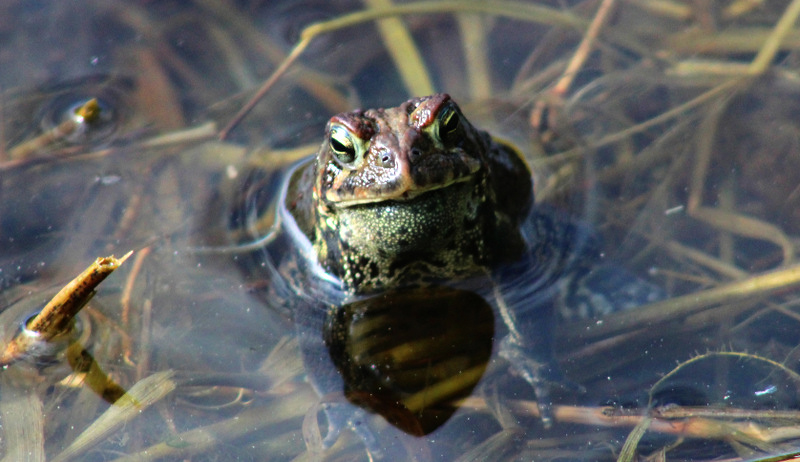
Often overlooked, forgotten or even feared, toads make great garden friends, warts and all. They show up in healthy, balanced environments and provide excellent pest control services. Allow these wild friends to help you manage your garden by creating spaces where toads can thrive.
Toads are a type of frog, but they are specialized to have a more terrestrial life. Out of 95 frog species in North America, 21 are toads. American toads (Anaxyrus americanus, formerly Bufo americanus) are probably the most common toad in our gardens. They eat thousands of mosquitoes, slugs, worms and beetles, and they play an important role in a balanced ecosystem. Toads are born in water as tadpoles. They grow limbs and feet that lack the webbing of aquatic frogs, after which they move to dry land as adults. They will return to the water’s edge for protective cover, to eat aquatic insects, to stay hydrated and to reproduce.
A distinguishing characteristic of toads is the special glands on the head called paratoid glands that secrete bufotoxin. It won’t cause warts if you handle them, but it could irritate your skin. It also will probably repel a dog or cat. Such domestic predators might learn their lesson, but there are other risks in the neighborhood. Yards and gardens that use chemical pesticides can be a deadly place for toads for two reasons: Insecticides kill toads’ food source, and harmful chemicals poison toads through their absorptive skin. Don’t let the warty bumps fool you: Toad skin is sensitive and is shed regularly. Unlike with snakes, you probably won’t find a toad skin in your garden. The resourceful creatures eat their own skin once it’s shed.
You don’t hear toads singing their nighttime chorus all year long, but they are still around. Springtime seems to be frog and toad season; the winter thaw and spring rains fill puddles where amphibians deposit eggs and sperm for a soupy fertilization. That’s why their songs can be heard filling the damp nights as they call to mates and ward off competition. While some migrate short distances, toads can live for decades in the same place they were hatched, surviving through all seasons. Their long lives might be due to their long naps. Toads are excellent hibernators in winter, but they need loose soil where they can burrow down below the frost line and spend months under the cover of moist earth.
Inspect your property and assess it from a toad’s point of view. If you were a toad, would you want to live there, or would your life be in danger every few weeks as a lawn mower comes ripping through? Toads are naturally found in grassy meadows and along river banks. Make the most of the natural features on your property and tweak them just a little to make room for wildlife. Could that soggy mud hole near a downspout become a picturesque amphibian sanctuary? Could your lawn become a colorful, low-maintenance arrangement of native grasses, such as prairie dropseed and little bluestem?
To attract and support toad life in your garden, create some protected areas that go undisturbed, such as loose piles of branches, overturned broken flower pots or other creative abodes at ground level. Keep a moderate supply of loose leaf mulch around for toads to find shade. Include native, flowering plants in your garden beds that attract all sorts of flying and crawling insects. By encouraging pollinators and making toad hiding spots, it gives toads a chance play a part in the garden food web.




